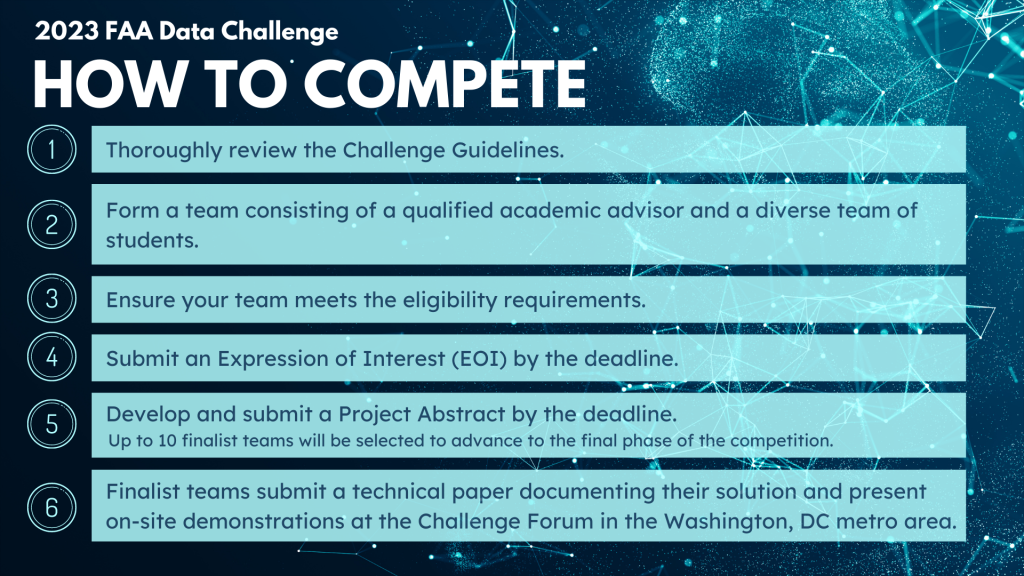2023 Competition Details
Background
The Enterprise Information Management (EIM) strategy is centered on using data more effectively to support the FAA’s mission and driving innovation through improved access to data. This FAA Data Challenge will provide a unique opportunity to involve university students in the FAA’s mission by offering creative and unique solutions to current and future challenges. We hope to create and stimulate a pipeline of talent who will become transportation leaders of tomorrow.
It is important that the FAA continues to ensure data-driven innovation in aviation that is encouraged across a broad spectrum of participants. To expand its reach to other schools and students, the FAA’s Chief Data Office (CDO) is hosting this Data Challenge. Students will have an opportunity to propose an idea in one of the theme areas and have their solution evaluated for an opportunity to win a cash prize. Over the course of the challenge, students will be challenged with:
- Working with unstructured data
- Deriving new insights by identifying and connecting complementary datasets
- Leveraging advanced analytics to enhance the value of data


Challenge Overview
This FAA Data Challenge will focus on the use of Artificial Intelligence/Machine Learning (AI/ML) and advanced analytics to explore aviation-related problems and opportunities. AI/ML is rapidly transforming many industries including aviation. The successful submissions will push the boundary and introduce novel approaches to aviation problems as the FAA moves further towards an info-centric National Airspace System (NAS).
The advanced analytics and AI/ML proposals should address one of the following categories:
Improve Aviation Safety
We are striving to be even smarter about how we enhance safety. By gathering and analyzing operational data, we can identify and address potential hazards and mitigate issues before they occur. AI/ML and big data can be used to identify trends, correlate events, predict outcomes, and move us closer to in-time analysis of safety of the overall system.
We also want to investigate how operational performance of the aircraft data could be collected for Part 91 (General Aviation) and similar operation types (e.g., using mobile application streaming data to the cloud or automated upload at base/service intervals) and used to identify safety issues, deviations, and enhance accident investigations. This capability is beneficial for aircraft that do not have a requirement for a flight data monitoring program (FDM).
Improve Operational Efficiency of the NAS
By sharing of real-time data about weather, the location of aircraft, and conditions throughout the National Airspace System, we can improve the operational efficiency. When we get the right data to the right people at the right time, we can make better decisions and use of available airspace and airport capacity.
Contribute to the Drive for Sustainable Aviation
Sustainable aviation will require progress along multiple dimensions; from sustainable fuels, improving operational efficiency, building the next generation aircrafts to minimizing environmental and social impacts; every aspect will be improved by advances in analytics.
Assist with the Rapidly Evolving New and Novel Uses of the NAS
There is tremendous growth in the aviation field, including demand for commercial and private services and new aircrafts being introduced. Leveraging modern analytical techniques (e.g., modeling, simulation) can allow us to rapidly simulate operational scenarios to evaluate risks and optimize operations.
For FAA Data Challenge inquiries, please contact the Program Team at FAADataChallenge@NIAnet.org.
The FAA Data Challenge is open to teams of undergraduate and graduate students at accredited United States-based colleges and universities. Teams may include senior capstone students, clubs, multi-university, or multi-disciplinary students. Minority Serving Institutions are highly encouraged to apply.
- Student team members must have been enrolled in a United States-based college or university for at least one semester (or quarterly equivalent) during the 2022-2023 academic year.
- Team members, including all faculty advisors and students, must be citizens or permanent residents of the United States.
- Each member of the team must meet the eligibility criteria.
- An individual may join more than one team.
- Team sizes may vary widely. The core team must contain, at a minimum, one faculty advisor from the lead academic institution and two students who have worked on the project and will present the final project at the culminating FAA Data Challenge Forum.
- Eligibility is limited to students from colleges and universities in the United States.
- A university may submit more than one abstract.
- A faculty advisor may advise more than one team.
Foreign Universities: Because this is an FAA-sponsored competition, eligibility is limited to students from colleges and universities in the United States. Foreign universities are not eligible to participate in the Challenge.
| DATE | MILESTONE / DELIVERABLE |
| October 15, 2022 | Challenge Announcement (Announcement as PDF) |
| November 6, 2022 | Submit an Expression of Interest (EOI) |
| November 16, 2022 | Q&A Session Webinar #1 |
| January 4, 2023 | Submit questions for Q&A Session Webinar #2 |
| January 18, 2023 | Q&A Session Webinar #2 (Register Here) |
| *February 12, 2023 | Submit an Abstract *Deadline extended |
| February 28, 2023 | Teams Notified of Selection Status |
| May 7, 2023 | Finalists Submit Technical Papers |
| June 14, 2023 | Finalists Submit Presentation Files |
| June 21-22, 2023 | 2023 FAA Data Challenge Student Competition Forum at MITRE, McLean, VA |
The lead university of the top three (3) teams will be awarded a $10,000 cash prize. One (1) additional $15,000 cash prize will be offered to the university with the best overall submission. Student participants of each finalist team will receive certificates.
TRAVEL REIMBURSEMENT FOR FINALIST TEAMS
Ten finalist teams will be selected to compete at the 2023 FAA Data Challenge Forum in June 2023. A travel reimbursement of up to $8,000 will be awarded to each of the 10 finalist teams to help offset the cost of traveling to the Washington, DC metro area to demonstrate their concepts at the Challenge Forum.
- FAA Data Portal
- FAA Data & Research site
- Sherlock Data Warehouse
- FAA Data Catalog
- Bureau of Transportation Statistics site
- Bureau of Statistics – Top 50 U.S. Airports Dataset
- A “Team” is defined as all participants in the submission, including all academic institutions, faculty advisors, students, organizations, and industry partners.
- The Prize Administrator (National Institute of Aerospace, or NIA) will administer the award of a single dollar amount to the designated lead academic institution of the winning teams. The lead academic institution for each team is solely responsible for allocating any prize funds among its team members as they deem appropriate.
- In order to enter the competition officially, an Abstract must be submitted per the above requirements defined in the “Submitting an Abstract” section.
- All submissions must be in English and as an Adobe PDF file. Scanned hand-written submissions will be disqualified. Additional format requirements may be listed on the FAA Data Challenge website, https://faadatachallenge.nianet.org.
- The team and/or team members may not be a Federal entity or Federal employee acting within the scope of employment (this includes co-op students with civil servant status).
- Team members may not be an employee of the DOT, including but not limited to the FAA.
- Teams will not be deemed ineligible because a team member used Federal facilities or consulted with Federal employees during a competition if the facilities and employees are made available to all teams participating in the competition on an equitable basis.
- Proposing team members are not permitted to consult with the Steering Committee (SC) or any of its committee members other than the invitation to participate in scheduled Question and Answer (Q&A) Sessions and the follow-up technical question opportunity set forth in #9. This opportunity is offered to the teams that submit an Expression of Interest by the deadline.
- After the first Q&A Session with the SC, and should the students and faculty have follow-up technical questions, follow-up technical questions should be submitted to NIA. NIA will forward the question to the SC. After receiving a response from the SC, NIA will post follow-up questions and answers on the FAQ webpage of the Challenge website.
- The FAA Data Challenge is subject to all applicable Federal laws and regulations. Participation constitutes the team’s full and unconditional agreement to these rules, terms, and conditions and to the final decisions of the FAA, which are final and binding in all matters related to this competition.
- Each team represents and warrants that the team is the sole author and owner of the submission, that the submission is wholly original and authored by the team, that it does not infringe on any copyright or any other rights of any third party of which the team is aware, and, if submitted in electronic form, is free of malware. All submissions remain the property of the team.
- By submitting an entry, teams agree to assume any and all risks and waive any claims against the Federal Government and its officers, employees and related entities (except in the case of willful misconduct) for any and all injury, death, damage, or loss of property, revenue or profits, whether direct, indirect, or consequential, arising from their participation in the competition, whether the claim or cause of action arises under contract or tort.
- By submitting an entry, teams agree to indemnify the Federal Government against third-party claims for damages arising from or related to the FAA Data Challenge activities.
- The SC has the right to request additional information and access to supporting materials from the teams.
- The submission cannot have been submitted in the same or substantially similar form in any previous Federally sponsored contest.
- Each team grants to the FAA, the DOT, as well as other Federal agencies and organizations with which it partners, the right to use names, likeness, application, and submission materials not marked with protective markings, photographs, voices, opinions, and/or hometown and state for FAA promotional purposes in any media, in perpetuity, worldwide, without further payment or consideration.
- Personal information submitted by teams as part of the Expression of Interest and/or submissions through the Challenge website will be transmitted to the FAA and may be kept in a system of records. Teams understand that the FAA Data Challenge website is hosted by a private entity, the Prize Administrator (NIA), and is not a service of the FAA or the Federal Government. The collection of personal and individually identifiable information on the challenge website is subject to the Prize Administrator’s privacy and security policies. Teams agree not to hold the FAA or the Federal Government liable for the protection, use, or retention of any personal information submitted through the Challenge website and/or in the team’s Expression of Interest or submissions.
- Submission Marking and Freedom of Information Act (FOIA), 5 U.S.C.§552: All materials submitted to FAA as part of a submission become FAA records and are subject to release under the FOIA. Any confidential commercial information contained in a submission should be designated in writing at the time of submission.
- Protective markings should be included as follows:
- The cover sheet of the submission must be marked as follows and must identify the specific pages containing trade secrets or commercial or financial information that is privileged or confidential: Notice of Restriction on Disclosure and Use of Data: Pages [list applicable pages] of this document may contain trade secrets or commercial or financial information that is privileged or confidential and is exempt from public disclosure. Such information shall be used or disclosed only for evaluation purposes. The Government may use or disclose any information that is not appropriately marked or otherwise restricted, regardless of source. [End of Notice]
- The header and footer of every page that contains trade secrets or commercial or financial information that is privileged must be marked as follows: “May contain trade secrets or commercial or financial information that is privileged or confidential and exempt from public disclosure.”
- In addition, each line or paragraph containing trade secrets or commercial or financial information that is privileged or confidential must be enclosed in brackets.
- If the team’s submission has been marked as set forth above, the team will be notified of any FOIA requests for their submissions. Teams then have the opportunity to review materials and work with an FAA FOIA Coordinator prior to the release of materials.
- Protective markings should be included as follows:
- The Prize Administrator is the National Institute of Aerospace (NIA). The Department of Transportation, Federal Aviation Administration (FAA), is the Federal Agency sponsor of the prize.
- Federal grantees may not use Federal funds to develop submissions.
- Federal contractors may not use Federal funds from a contract to develop submissions or to fund efforts in support of a submission.
- Teams must include all the required submission elements. The Prize Administrator reserves the right to disqualify submissions after an initial screening if all required submission elements are not provided and/or if eligibility requirements are not met. The Prize Administrator may give teams an opportunity to fix non-substantive mistakes or errors in their submission packages.
- The FAA retains sole discretion to select the winning team(s). The FAA reserves the right to not award the prize if the SC believes that no submission demonstrates sufficient innovative scientific and engineering potential and/or achievements.

